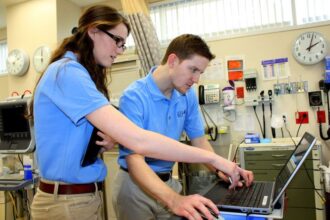It can be hard for doctors to give bad news , especially when a patient dies. Using the GRIEV_ING mnemonic can help you do a better job !
Gather: Ensure that all family or survivors are present. Offer to call others or wait for them.
Resources: Call for support resources that are available, such as friends and ministers. Start this process while still in the resuscitation room.
It can be hard for doctors to give bad news , especially when a patient dies. Using the GRIEV_ING mnemonic can help you do a better job !
Gather: Ensure that all family or survivors are present. Offer to call others or wait for them.
Resources: Call for support resources that are available, such as friends and ministers. Start this process while still in the resuscitation room.
Identify: Identify yourself. “I am Dr. Hobgood, the one taking care of your mother.”
Identify the deceased or injured patient by name. Identify the family’s understanding of the day’s events. Identify that you are bringing bad news. “Fire the warning shot: ‘Things were not going well.’ You have to [prepare them for] the fact that the news is bad.”
Educate: Briefly educate the family about the events that have occurred in the emergency department.
Educate them about the current state of their loved one. “Fire another warning shot if needed.”
Verify: Verify that their family member has died. Be clear! “You cannot use euphemisms. You have to say ‘dead’ or ‘died.’ “
(Space _): Give the survivors personal space. Stop talking. Allow them to absorb the information.
“You can touch them if you feel comfortable doing this. You can give them permission to cry by handing them a box of [tissues],” she said.
Hugging is okay, if you feel all right doing so. “Sometimes those hugs are the most consoling part of this whole thing,” Dr. Hobgood added.
Inquire: Ask if there are any questions. Answer them all. Take the time–this sends an important message.
Nuts and bolts: Ask about organ donation, funeral services, and personal belongings. Offer the family the opportunity to view the body. “There is often a great deal of comfort in viewing the body.” Tell them that the room is a mess, that the patient doesn’t look like they might expect to facilitate this viewing; but “giving them the choice is very important,” said Dr. Hobgood.
Give: Give them your card and access information. Offer to answer any questions that may arise later.
“Tell them ‘I am here for you. You are going to have questions.’ This speaks volumes,” she said.
“I have been doing this for 5 years, and only five people have called me, all to say, ‘Thank you.’ Always return their calls.









